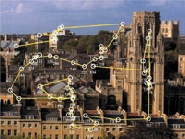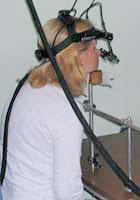I have just come back from a holiday in South Africa where I spent a lot of time watching wildlife. But unlike going to the zoo, there is no guarantee that you will see any animals, since the majority are well camouflaged against a mottled background. Sitting in our safari jeep, we constantly scanned the bush with our eyes.
Visual search – looking for a target object in the presence of a number of distracter items – is an everyday activity for humans. Our eyes move incessantly, reflecting our active exploration and monitoring of the visual environment, whether it is in the bush or in a more familiar place. The eyes make fast movements called saccades which are followed by fixations when they are stationary. Saccades are ballistic – once initiated the saccade cannot change direction. They are also incredibly fast, reaching, for example, a peak velocity of about 50 km/hour for a single movement from one side of this page to the other. At these speeds, useful visual information is only collected during the periods when the eyes are fixating. Patterns of fixation, therefore, indicate the way in which our eyes sample the visual environment.
Saccades are required to rapidly sample the visual world because our visual ability is not the same across the visual field. It is much better in the centre of the field and drops off quite dramatically at the periphery. If I want more detailed information about things on the periphery, I have to shift my point of fixation by moving my eyes and even turning my head. So the very front end of the brain – our eyes – are highly specialised in how they structure information. That is not to say that we do not process information on the periphery, but the brain is optimised to process information from what we are directly looking at. Because eye movements are so quick – in 10 milliseconds I can turn my head to look at something in the room, fixate on it for 200 milliseconds and return my head to the page in another 10 milliseconds – I don’t need to be able to see everything in detail because I can find out additional information so quickly. In this way I have the illusion that I know what is going on all around me. In addition, it seems that it is more efficient to have a ‘quick and dirty solution’ which randomly searches very quickly and which may give you the answer you require, than to adopt a more methodical, but slower, process. If you have a very quick-responding system, it does not matter too much if it makes a mistake.
We have to be selective about what we look at, whilst gathering as much information as possible
To study accurately the way we look at things, Iain Gilchrist works with sophisticated eye-tracking equipment, funded by the Wellcome Trust, which records eye movements using an infrared video system. The system can very accurately monitor, in both eyes, the point of fixation within 0.2 degrees of visual angle, or 2mm on a computer screen at normal viewing distance. The demonstration I watched entailed the subject sitting and reading text she could see on the screen, while the movements of her eyes were monitored and recorded. Interestingly, what I could see, looking at the screen over her shoulder, was only rows of Xs. However, as her eyes passed over the text she could see, the Xs I could see turned to text, so I could follow exactly where her eyes were going. It was fascinating to watch.
Reading provides one of the clearest and best-characterised examples of how visual processes and eye movements are coordinated to acquire information. Most saccades are to the right, although a small proportion are regressive. Rightwards saccades are typically between seven and nine characters long, although the length can vary considerably, depending on the text and the individual reader. Steady fixation is maintained between saccades, typically lasting between 200 and 250 milliseconds. It is during fixation that information is gathered from the text. At the end of each line, subjects make a large leftwards return saccade that orients the eyes to the beginning of the next line.
In addition to investigating how people normally see and read, Gilchrist’s research involves studying people who suffer from a diverse range of visual disorders. One of these individuals was unable to make any eye movements at all and has not been able to do so since birth. To compensate she uses movements of the head which are saccadic in that they show many of the features that characterise saccadic eye movements. Surprisingly, she reports no major visual problem associated with her condition and her overall reading speed is consistent with slow, but not abnormal, reading. Her case suggests that saccadic movements, of the head or the eye, form the optimal sampling method for the brain. Given the additional mass of the head, the fact that such saccadic movements are adopted as an alternative strategy by this individual indicates that moving the whole head in a saccade-like fashion many thousands of times a day is the optimal solution.
A patient might be unable to find their glasses, although they are right beside them, but on the side they cannot ‘see’
Gilchrist is also interested in brain systems and processes that support these behaviours, so he works with stroke patients whose impairments often provide insight into what parts of the brain control which functions. When a patient has a stroke, a particular part of the brain is deprived of its blood supply, which generally results in quite specific damage. For example, a patient with right-parietal damage might have perfectly good linguistic abilities and an intact memory, but may well have ‘Visual Spatial Neglect’, a disorder in which things on one side of space are ignored. Such a patient might be unable to find their glasses, although they are right beside them, but on the side they cannot ‘see’. It is not that they are blind, they are just unable to do a visual search in that particular space.
There are standard tests that can be done with these patients, one of which is a cancellation task (see ‘Star’ illustration). Tracking eye movements during these tasks demonstrates the subtle differences between patients’ behaviour, that relate to exactly where the damage is in the brain. As a result, Gilchrist can begin to map the clinical features of these disorders and a functional understanding of how the brain gathers visual information, onto the parts of the brain that are involved. The results then feed into other people’s work on the rehabilitation of these patients.
Gilchrist is also working with colleagues in the Electrical Engineering Department who are interested in how eye movements can be used to help combine complex sets of visual information. For example, radar information on a screen that needs to be combined with a satellite map – how can the display be optimised so that the process is efficient? Ultimately, as the world becomes more complicated and technology-driven, we shall have to design better machines based on the biology of the human, so increasingly there are people in industry interested in working with Gilchrist to get these things right. Only when these disciplines are intricately meshed together will it be possible to build interfaces that really work.

